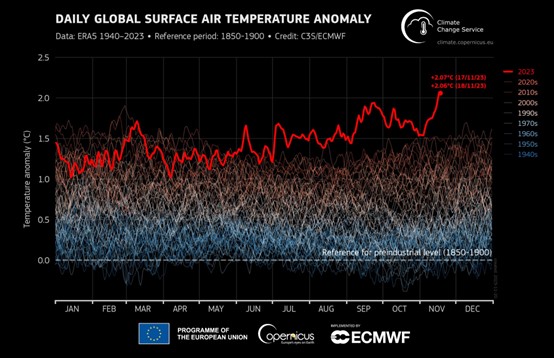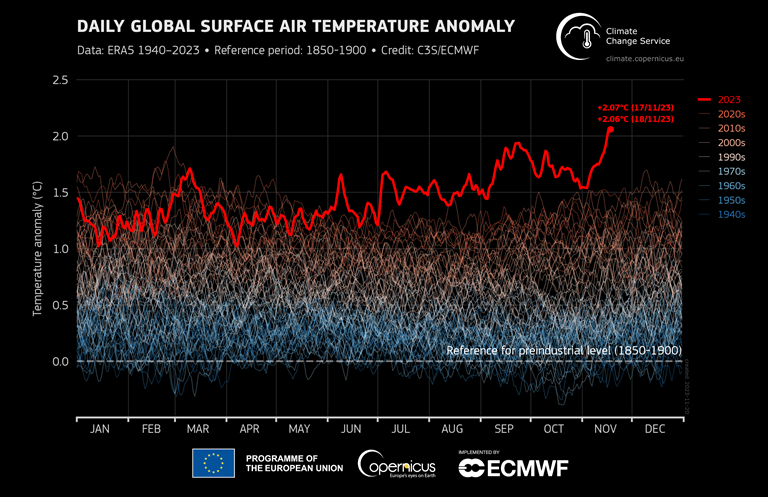The world is set to record its hottest year ever. Both on land and in our oceans, and not by a small amount, by an astronomical amount.
NASA’s scientists have documented that this year’s months of June, July and August combined were 0.23°C warmer than any other northern-hemisphere summer in recorded history and 1.2°C warmer than the long-term average[1]. This new record comes as exceptional heat swept across much of the world, contributing to deadly wildfires in Canada and Hawaii, and searing heat waves that struck Europe, South America, Japan, the Middle East, Brazil and the U.S.
In November 2023, for the first time ever, the Earth briefly surpassed another climate milestone, with global temperatures averaging more than 2°C hotter than levels before industrialisation (17 - 18 November 2023)[2], depicted in Figure 1.
This extreme rise in land temperature is replicated in our oceans. NOAA (National Oceanic and Atmospheric Administration) has just recorded the fifth consecutive month that global sea surface temperatures have hit a record high, with August setting a new record for the highest global ocean temperature since measurement began[3]. Again, these record-breaking ocean temperatures coincide with numerous marine heatwaves being documented simultaneously around the globe.
This article captures the discussion led by Dr Nick Wood, Energetics Climate Risk Expert, and Dr Ghislaine Platell, Energetics Physical Risk and Resilience Lead.


Figure 1: Daily global surface air temperature anomaly for 1940-2023 with reference to the 1991-2020 average (Credit: C3S/ECMWF)
Listen to our podcast.
The following is based on the transcript of the podcast episode.
When we talk about extreme heat, what are we talking about? And why does it matter?
(Ghislaine) It's really terrifying to see the extreme temperatures that are being recorded at the moment. I hate to use the word “unprecedented”, which has been a bit of a buzzword recently, but we haven't really seen this sort of temperature change on a global scale. Another example that illustrates the urgency of this is the reduction of the sea ice extent in Antarctica, which is the area of ice that covers the Southern Ocean at any given time. Its dramatic reduction is driven by the extreme ocean heat we've been seeing recently, with this year's maximum over 1,000,000km2 below the previously lowest recorded extent of winter sea ice set in 1986[4]. We've got 45 years of recorded data for the sea ice extent in Antarctica, and this year is like nothing we've seen before.
Today we're focusing on extreme heat, which I sometimes refer to as “the scary stuff”. We often hear about average increases in temperature, for example, what is a 1.5°C, 2°C, 4°C world going to look like? For many, it's quite hard to imagine. But, if we're talking about real tangible examples of extreme heat, like we're in the midst of at the moment, then it feels a lot more real and it's quite alarming.
So, to answer your question, of “what is extreme heat”, my answer is that it can mean different things in different contexts. As a broad definition, it's a temperature that is much hotter than the average in a specific location. Due to that location specific definition, if you have a heat wave, which is multiple days of extreme heat, the threshold that counts as a heat wave is going to be different. It's specific to the long-term records in that location. Extreme heat will increase chances of being exposed to heat related illness and in extreme cases can cause death (as seen with the recent tragedy that occurred at Taylor Swift’s concert in Brazil[5]). So, as the temperature and the climate changes over time, you can see all those risks increasing as well.
(Nick) The other thing that's keeping me awake at night, is not just the change in the nature of the hazard, but also the change in the nature of the vulnerability. Essentially as a society we’re going the wrong way. We’re designing and building our cities and communities, which cannot manage urban heat. An example of this is urban heat islands; we're increasingly dependent on the power grid, which has resilience issues in extreme heat; we’re building our high energy usage buildings (eg. hospitals and airports) in the wrong place without taking into consideration the future. There's more to this than just the hazard. There's also that interconnectivity with the vulnerability. Vulnerability is increasing at the same time as the hazard is increasing, and I think that's problematic.
How prepared are Australian businesses for addressing extreme heat?
(Nick) Not very! The future is not like the past, we’re heading into uncharted territory. Many businesses don't have the systems in place. They don't have the governance, the risk management, or processes in place to deal with this.
(Ghislaine) We've seen a whole range of different businesses, and they’ll have to tackle it differently. To me, what makes it really difficult is we're talking about one hazard, but in practice it means a lot of different things.
An example could be impacts to a business' workforce. If they're working outdoors, they're increasing their exposure to heat related illness. As a business if you’re looking to avoid that risk, you might instil more breaks, or avoid working when people might be exposed to those really hot hours of the day. But then you’re facing a loss in productivity instead. Even if working indoors, you need to consider if your air conditioning units are designed to withstand projected temperatures, and maintain that equipment more frequently.
Another example could be around impacts to buildings, roads, infrastructure, etc. Again, businesses need to consider the design standards for all of those. Looking at supply chains specifically, if you’re a retail store, how many days of stock do you have on hand so that if something happens to the roads or the rail (used to deliver your products) you can still keep doing business.
For agricultural businesses extreme heat may mean a reduction in yield or growth if the animals are stressed and focused on keeping cool. It will potentially impact crops as well if you have an extreme heat day or multiple days at a really awkward time in the growth cycle. You might lose a whole bunch of crops in those conditions.
We're really talking about a systemic risk.
What can Australian businesses do to get themselves in a better position for addressing the impacts and implications of extreme heat?
(Nick) It's pretty clear why this should be an increasing priority for Australian businesses. It's dangerous, it's almost impossible to stop, and it impacts everything. Essentially what can they do? We’re at the point in time where there's been a big development in the need for businesses to step up their governance, their strategy, their risk management, and their reporting of these types of these types of situations, particularly around Task Force on Climate-Related Financial Disclosures (TCFD) elements.
(Ghislaine) To me we're talking about how businesses are going to adapt. All the way from governance systems, to risk management processes, to metrics and targets. How do you track that over time? How are you performing? Is it working? If someone was to faint, is that heat related? Are you tracking that in your system so that you can keep an eye on how this hazard is impacting your business already?
How a business adapts is quite specific to the sector that they work in, the types of operations, and their location. A tool that businesses can use is scenario analysis, to play out what the future might look like for them, and which decisions might be beneficial across multiple scenarios. That will also raise the question of how far as a business you want to adapt. Do you adapt to the worst possible risk, meaning you’ve potentially over adapted? Or do you do less but accept you are potentially unprepared? Finding that middle ground is really important.
There’re a few things that can be done, from implementing incremental changes to transforming the way you do business, but it all starts with treating extreme heat as a reality as part of your risk assessments and conducting a scenario analysis to explore the range of potential impacts and opportunities.
Why is the Latin phrase "Libera Te Tutemet Ex Inferis" in the podcast title?
(Nick) I’m sure a number of people are really interested about why we have a Latin phrase in our episode title. The words "Libera Te Tutemet Ex Inferis" appear in one of my favourite sci-fi horror films 'Event Horizon'. What it translates to is "Save yourself from hell". That may sound like a rather provocative title, but when you look at the level of extreme heat, when you see the data that NASA and NOAA are releasing, and really understand what it means in a statistical sense, this is a very bad place for us to be heading towards. And there's no underplaying just how serious this situation is for the world.
(Ghislaine) I agree this is a serious situation and can be really confronting to see these “scary” projections for the future. I think to address extreme heat, it's important to have an understanding of future scenarios and the data underpinning them. But it can also be quite paralysing to be faced with an issue that seems so large and so hard to resolve. So, my advice to Australian businesses is to remember that taking action is what's most important in the end, and there are actions that can be taken to mitigate the impact to businesses going forward.
Is your business ready for the impacts of deadlier heatwaves and worsening fire conditions?
To better understand the range of potential impacts, Australian companies need to apply a rigorous risk assessment supported by realistic, science-based scenarios, across their value chain to identify opportunities to enhance their resilience. This will also ensure that they are well prepared for emerging mandatory climate disclosures.
[1] NASA | NASA Announces Summer 2023 Hottest on Record (14 September 2023); the baseline for the 1.2°C increase is 1951-1980.
[2] European Centre for Medium-Range Weather Forecasts (ECMWF) | Global temperature exceeds 2°C above pre-industrial average on 17 November (21 November 2023)
[3] NOAA | The world just sweltered through its hottest August on record (14 September 2023)
[4] NSIDC | Antarctic sets a record low maximum by wide margin
[5] The Guardian | Must the show go on? Taylor Swift fan death highlights danger of live shows as Earth cooks (24 November 2023)








